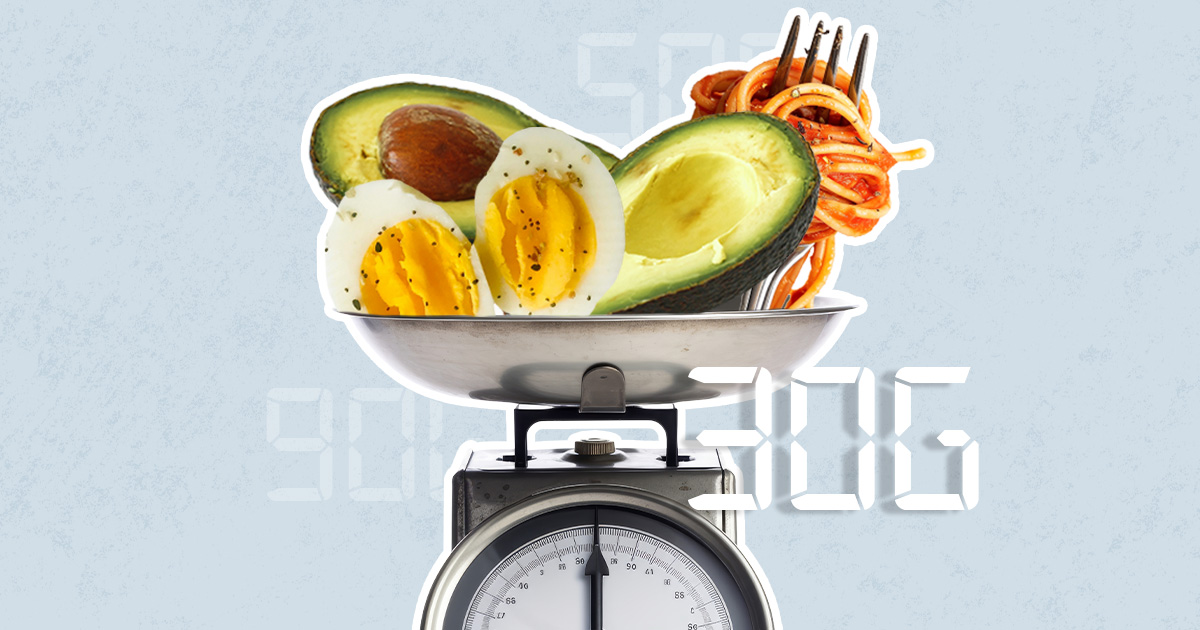Forget trying the next quick fix and restricting foods; instead, you’re fueling your body with just the right balance of protein, fiber, and fats every day, giving you more energy than ever, with the bonus of actually shedding pounds. The *chef’s kiss* macronutrient formula? The 90/30/50 method by creator and registered dietitian Courtney Kassis has reportedly helped her clients reverse chronic conditions and lose weight within weeks, after not seeing results for years. How does it work? “Together, these nutrients increase metabolism, promote satiety, balance blood sugar, and increase lean muscle mass—all of which support optimal health and weight loss goals,” Kassis said. With a slew of weight loss tips and tricks being touted on TikTok, what makes the 90/30/50 method effective? Read on for a detailed breakdown of the latest weight loss method, including tips to try it for yourself.

MEET THE EXPERT
Courtney Kassis MS, RDN, LDN
Courtney Kassis is a registered dietitian nutritionist. She is renowned for her innovative approach to nutrition, having successfully achieved remission from Hashimoto’s disease using the 90/30/50 method.
What Is the 90/30/50 Method?
After experiencing her own weight struggles for years, Kassis knew she needed to make a change to her nutrition plan. “I realized that, although I was eating less, I wasn’t focusing on eating enough of the right nutrients to help me actually see results,” she explained. “I was under-consuming protein, fiber, and healthy fats (and over-consuming carbohydrates and sugar), leading to frequent hunger, fatigue, low muscle mass, lack of weight loss, brain fog, and more. I was not losing weight, and my autoimmune disease (Hashimoto’s) went into a complete flare.” Unlike many weight loss tactics that restrict calories, Kassis focused on adding nutrients. After two months following her 90/30/50 method, she lost 15 pounds, and her autoimmune disease is now in remission.
So, what exactly is the 90/30/50 method? It’s a structured nutrition plan that focuses on achieving a minimum daily intake of 90 grams of protein, 30 grams of fiber, and 50 grams of healthy, anti-inflammatory fats (more on that to come), emphasizing the quality and balance of macronutrients rather than strict calorie counting. According to Kassis, the goal of this approach is to promote long-term health benefits and improved overall wellness. “By meeting the minimum daily requirements, individuals can support blood sugar balance and hormone regulation, promote satiety, regulate appetite, and enhance metabolic health,” she said. “These nutrients work synergistically to create a balanced and sustainable approach to nutrition that can lead to improved overall well-being and weight management.”
Based on one of Kassis’ “What I Eat in a Day” TikTok videos, a day of eating following the 90/30/50 method could look like this:
- Breakfast: peas and feta breakfast wrap (1 egg, peas, and feta in a gluten-free tortilla)
- Snack: avocado rice cake (½ avocado, rice cakes, Everything But the Bagel seasoning)
- Lunch: chicken and asparagus stir fry (5 ounce chicken breast, asparagus, and quinoa with tamari or coconut aminos)
- Dinner: za’atar chicken, cauliflower, and leeks (4 ounce chicken breast cooked in olive oil with za’atar seasoning, cauliflower, leeks, and mini potatoes)
- Snack: banana blueberry ice cream (frozen banana, frozen blueberries, ginger, and almond milk)
How Does It Work?
Kassis said the 90/30/50 method works by prioritizing a balanced intake of macronutrients daily to support blood sugar balance and weight loss: “These are the amounts needed to facilitate results like metabolic support, growth of lean muscle mass, improved gut health, and more.”
Why 90 grams of protein?
A higher protein intake increases the levels of the satiety hormones GLP-1, peptide YY, and cholecystokinin while reducing the levels of the hunger hormone ghrelin. With its impact on metabolism (protein increases the rate at which your body burns calories) and positive effect on maintaining lean muscle, research shows that eating enough protein supports fat loss and improved muscle tone. But why 90 grams of protein? According to Kassis, it’s the minimum amount of protein needed to facilitate the growth of lean muscle mass. Additionally, when consumed with fiber (more on that below), protein helps slow down the absorption of sugar into the bloodstream, preventing spikes in blood glucose levels. When blood sugar is out of balance, it can negatively affect the metabolic rate, hindering the ability to lose weight.
Why 30 grams of fiber?
While dietary fiber—found mainly in fruits, vegetables, whole grains, and legumes—may best be known for its ability to prevent or relieve constipation, it can also help stabilize blood sugar levels and reduce the risk of insulin resistance (when cells in the muscles, fat, and liver don’t respond well to insulin and can’t easily take up glucose from the blood, resulting in excessive sugar in the blood). “Including at least 30 grams of fiber in your daily diet promotes digestive health, regulates bowel movements, and helps control blood sugar levels,” Kassis said. “Fiber-rich foods provide bulk to your diet, promoting feelings of fullness and supporting gut health. Additionally, high-fiber foods are often lower in energy density, meaning you can eat more food with fewer calories, supporting weight loss efforts.”
Why 50 grams of fats?
“Contrary to the common misconception that fats lead to weight gain, healthy fats (monounsaturated and polyunsaturated fats) can actually aid in weight loss,” Kassis said. “They help you feel satisfied after meals, reducing the likelihood of overeating.” Kassis also pointed out that consuming 50+ grams of healthy fats, such as those found in avocados, nuts, seeds, and olive oil, plays a crucial role in hormone production (hormones control hunger, fullness, metabolism, and fat distribution), which is essential for metabolism and weight management.
A study in Clinical Nutrition found that a diet rich in monounsaturated fat improves insulin sensitivity, allowing cells to better respond to insulin and regulate blood sugar levels effectively. Without proper blood sugar control, the body stores fat. TL;DR: Eating unsaturated fats increases fat burning and reduces fat storage.
Tips to Try It for Yourself
Increase your fiber intake gradually
Start by gradually incorporating the 90/30/50 ratios into your meals—namely fiber—to allow your body to adjust to the new nutrient balance. If you aren’t currently consuming close to the suggested 30 grams of fiber, slowly increase your intake by 5 grams every week to avoid gas, bloating, and cramps. Eat a variety of fruits, vegetables, whole grains, and nuts to include a mix of different fibers and a diverse range of nutrients in your diet.
Plan meals in advance
“Random recipes lead to random results,” Kassis said. Take 10 minutes out of your weekend to plan out how you’re going to reach the daily targets during the week. To hit the daily goal, aim for 20-30 grams of protein, 7-10 grams of fiber, and 10-15 grams of healthy fats per meal. By planning out specific meals—whether they’re home-cooked or takeout—you remove the decision fatigue that inevitably comes with the “What’s for dinner?” dilemma after a long day of work.
Keep track of your nutrients
While estimating your macronutrient intake may be less time-consuming, it’s easy to under or overestimate portion sizes, so using a nutrition tracker or app like MyFitnessPal when you’re first starting the method can take the guesswork out of ensuring you’re meeting the recommended amounts of protein, fiber, and healthy fats. But once you get the idea of what 90 grams of protein, 30 grams of fiber, and 50 grams of fats look like, track your intake on your own; getting too stressed over tracking is worse for your body than not hitting nutrition goals.
Focus on quality over quantity
Kassis emphasized focusing on the quality of the foods you consume rather than just the numbers. Prioritize whole, nutrient-dense foods that are rich in essential nutrients—lean proteins (chicken, fish, and beans), complex carbohydrates (fruits, vegetables, and whole grains), and healthy fats (avocado, nuts, and seeds)—to support blood sugar balance and weight loss, but most importantly your overall health and well-being.
Please consult a doctor or a mental health professional before beginning or stopping any supplements, diets, or medications. Always seek the advice of your physician or other qualified health provider with any questions, and always personalize advice to what’s best for your body. Remember that every body is different and has different needs. Never disregard professional medical advice or delay in seeking it because of something you have read in this article.

